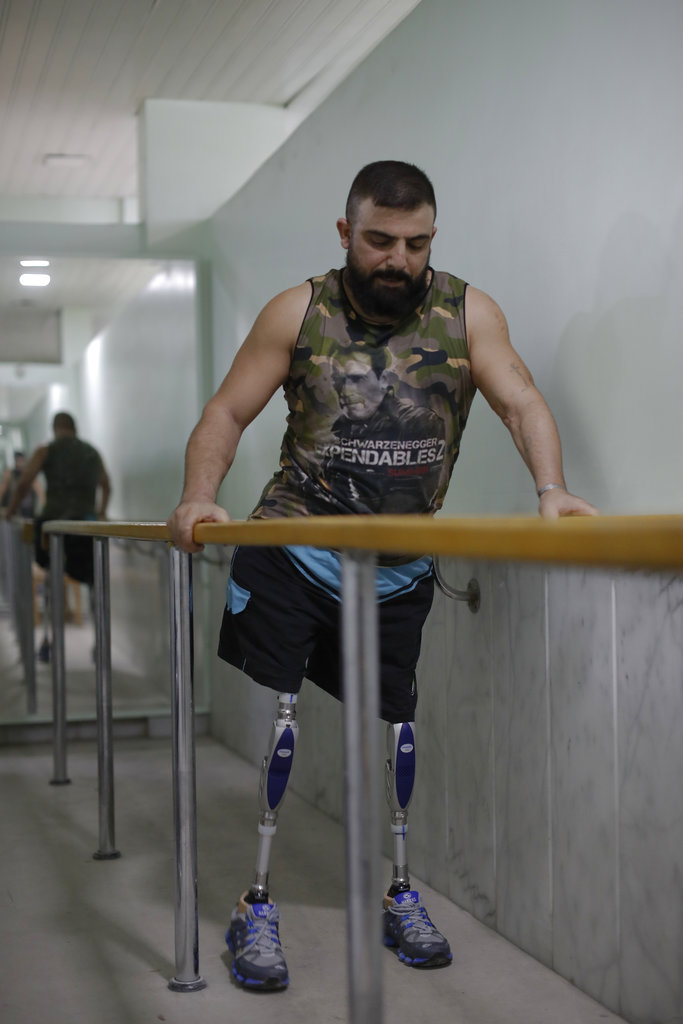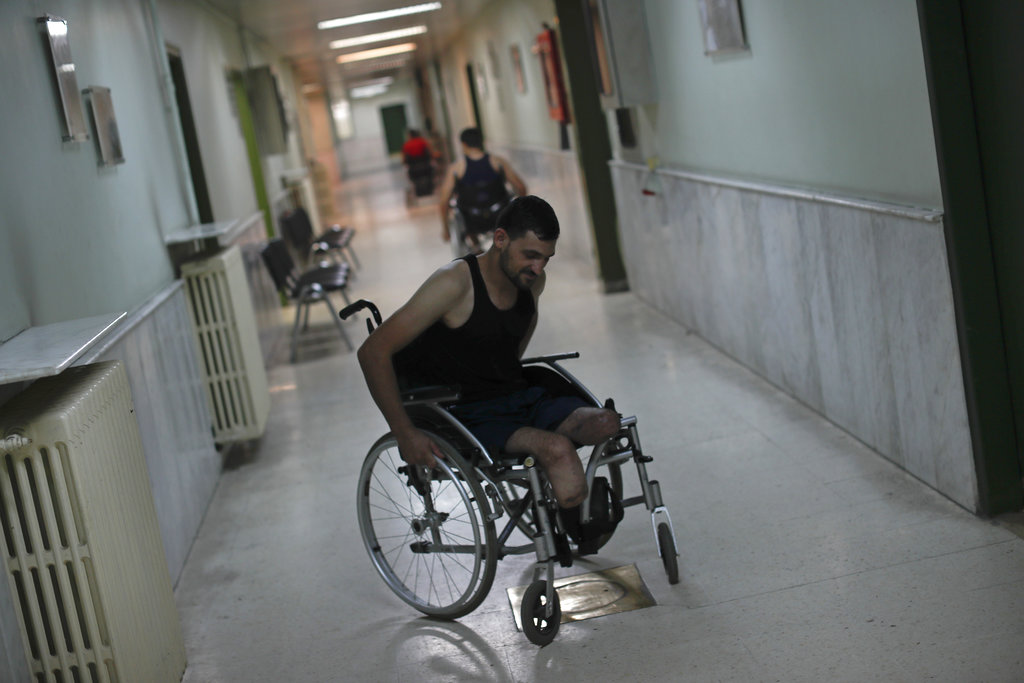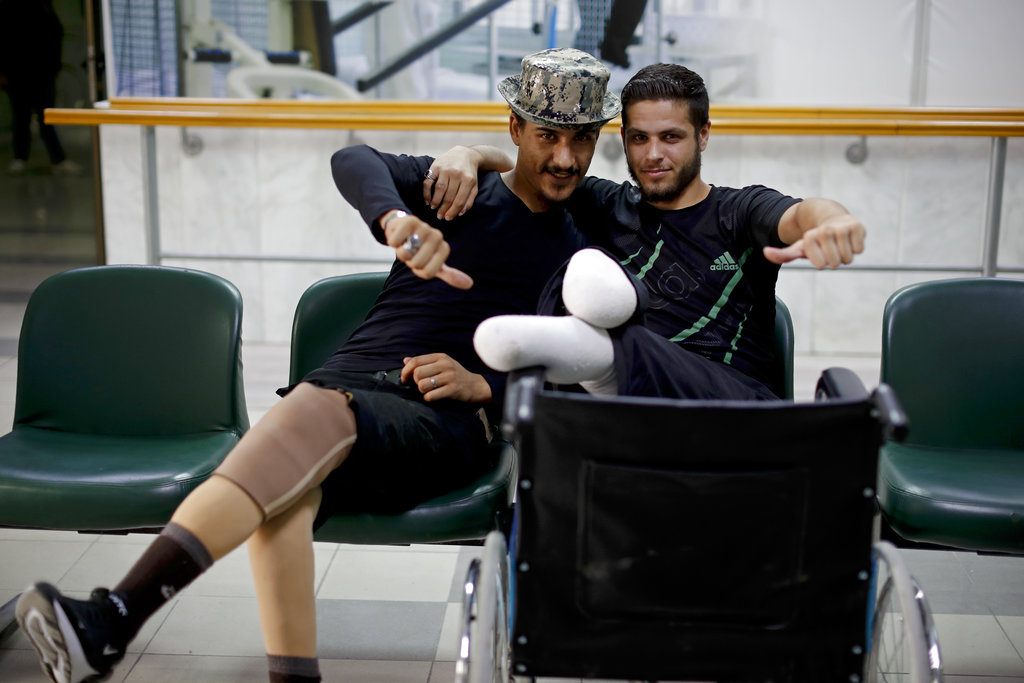In a Damascus hospital, Haidar Hussein lifts himself up, his hands holding on to a set of bars as he cautiously steps forward, showing off his new skills walking on artificial legs as his therapists cheer him on.
The 30-year-old soldier is inching toward the end of his 10-week physical therapy stint. With two more weeks to go, he is looking forward to return to his previous life as a grocery store owner.
Four years ago, at the height of the Syrian civil war, he was on a military mission in the central Hama province when his group was hit by two improvised explosive devices made from gas cylinders, known as “hell cannons”. Twenty-three of his comrades died. Hussein, whose legs were blown off, survived.
Now, after an arduous journey during which he went from hospital to hospital, battling infections and complications from the injuries, he is learning to walk with prosthetic legs. His upper arm was shattered and needed an external brace. It had to heal before he could put weight on it and learn to walk with prosthetics.
Wearing a sleeveless khaki T-shirt imprinted with Arnold Schwarzenegger’s face and the words “Expendables”, he takes small steps in the large exercise hall, sometimes stumbles but picks himself up again and continues.
“My injury gave me strength,” he said with pride. “I realised how strong I am, I had no idea I could be this strong.”

Haidar Hussein lost his legs while fighting on the front lines in Syria's war. AP
Hussein is one of Syria’s many soldiers who, after years of intense fighting, now face a new reality of living without one or more of their limbs, or with other serious disability.
Many are being treated at the Ahmad Hamish Martyr Hospital in the Damascus district of Barzeh, which has a centre for prosthetics and orthotics and offers physical therapy for members of the armed forces disabled as a result of injuries from the war. The centre uses advanced technology to manufacture around 60 prosthetic limbs a day, reflecting the high demand in a nation wracked by conflict for the past seven years.
The government provides no official statistics for the number of Syrian soldiers who have been killed or wounded in the war, although the number of casualties is believed to be in the tens of thousands.
Around 450,000 people are estimated to have died in Syria’s conflict, which erupted in March 2011 with protests that later evolved into armed confrontations and a full-blown civil war. Around half of Syria’s pre-war population of 23 million has been uprooted — nearly 6 million fled abroad, while 6.6 million are displaced within Syria — and entire cities lie in ruins, their infrastructure decimated.
According to a UNICEF report released earlier this year, over 1.5 million people are now living with permanent, war-related impairments in Syria, including 86,000 people who have lost limbs.
The Ahmad Hamish Hospital in Damascus is one of the largest facilities in Syria offering support for members of the military, which has been exhausted by the conflict. Troops have fought rebels and armed opposition groups on multiple fronts, as well as Islamic extremists, jihadis and militants such as the Islamic State group and al-Qaida-linked factions.
On Sunday when The Associated Press visited the hospital, a group of soldiers with various permanent injuries were exercising and doing pullups in the large, collective hall. Many appeared to be young, in their 20s. Some are double amputees like Omar
Beik, a 32-year-old soldier from the northern city of Aleppo.

Everyone in Syria has lost something. An arm, a leg or a life.
Khadijeh Ramadan, the mother of a soldier
Beik lost his legs in April when he stepped on a land mine in the final days of the battle for Damascus' eastern suburbs, known as eastern Ghouta. His right leg was blown off on the spot. It took him four hours to get to a clinic, by which time his other leg was bleeding profusely. Twenty days later, doctors had to amputate it.
“It was the hardest thing in my life, that I had to take my own leg and bury it with my own hands. It was the hardest moment. A part of me, my body, and it’s gone,” he said.
“But I still have the most precious thing, my spirit,” he added. A father of four girls, he plans to go back to them and 'start life from zero.”
Hospital officials say patients at the military hospital receive rehabilitation services and free prosthetics, along with support to help them adjust to living with a disability. Syrian President Bashar Assad and his wife, Asma, visited the hospital on numerous occasions over the past few years, offering support.
Roa Taleb, a social assistant, said a large number of the patients have difficulties dealing with inactivity, and some of them get depressed. But the hospital staff said they try to foster a sense of community among the patients, many of whom live there for round-the-clock treatment.

Omar Beik, a 32-year-old soldier from Aleppo, who lost his legs in April when he stepped on a land mine. AP
A common thread among the patients is pride in their country's military and its leader, Assad. The Syrian army has made a series of gains over the past year, possibly bringing the country's war closer to an end. But even if the fighting dies down, peace and reconciliation remain far off as the northern part of the country is still outside government control and millions of refugees are reluctant to return to Syria without an overall political settlement.
Hussein, like others, says he would return to the front line tomorrow if he could.
“My country is very important to me. A person without a country isn’t worth anything,' he says. “The country is the mother, it’s my mother, before even my real mother.”
Outside, by the entrance to the exercise room, a Syrian mother teared up. Khadijeh Ramadan was visiting one of her sons who was hit by an explosion during a fighting mission and now suffers from partial paralysis and lung problems. She has four other sons, all in the military.
The centre, with its amputees, is a microcosm of Syria, she said. “Everyone in Syria has lost something. An arm, a leg or a life.”










